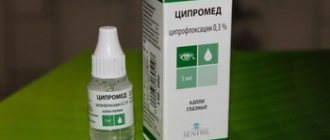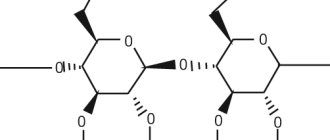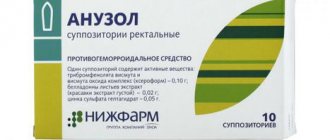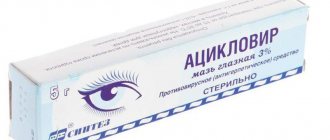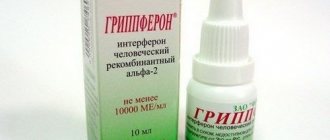Opatanol eye drops represent a pharmacological group of ophthalmic drugs that have anti-allergenic and anti-edematous therapeutic effects. They are prescribed for the treatment of allergic conjunctivitis in adults and children over 3 years of age. Clinical experience with the use of the drug in pregnant and breastfeeding women is limited.
Pharmacological group
The drug represents the pharmacological group of antiallergic agents for local use in ophthalmology. The active compound olopatadine suppresses the functional activity of histamine H1 receptors in tissues, and also inhibits the release of biologically active compounds from mast cells, which are responsible for the development of an allergic reaction (histamine, leukotrienes). The active substance does not affect other types of receptors, in particular dopamine, adrenergic, serotonin, and muscarinic receptors.
After instillation of eye drops, olopatadine is adsorbed into tissues, where it has therapeutic effects. It penetrates into the systemic circulation in small quantities. It is excreted from the body mainly by the kidneys in unchanged form.
Instructions for use OPATANOL
Suction
Olopatadine, like other topical drugs, undergoes systemic absorption. However, systemic absorption of topically administered olopatadine is negligible, and plasma concentrations can vary from the lowest quantifiable value (<0.5 ng/mL) to 1.3 ng/mL. These concentrations are 50-200 times lower than the concentrations after the administration of well-tolerated doses of the drug orally.
Metabolism and excretion
When studying pharmacokinetic parameters when prescribing the drug orally, it was revealed that T1/2 of olopatadine in plasma ranges from 8 to 12 hours, and excretion is carried out mainly by the kidneys. Approximately 60-70% of the dose received is found in the urine as the active substance. Two metabolites were also found in urine in low concentrations: monodesmethyl and N-oxide.
Pharmacokinetics in special clinical situations
In pharmacokinetic studies following oral administration of 10 mg olopatadine in young (mean age 21 years) and elderly (mean age 74 years) patients, there were no significant differences between plasma concentrations (AUC), protein binding, and urinary excretion of the parent drug unchanged. and not found in the form of metabolites.
Since olopatadine is excreted by the kidneys mainly in the form of unchanged active substance, impaired renal function causes changes in the pharmacokinetic parameters of olopatadine - in patients with severely impaired renal function (average CC value - 13.0 ml/min), its Cmax in plasma is 2.3 times higher than in healthy people adults. Following oral administration of 10 mg in hemodialysis patients (without urinary excretion), olopatadine plasma concentrations were significantly lower on the day of the procedure than on other days, suggesting that hemodialysis may promote the elimination of olopatadine.
A study was conducted in patients with severe renal impairment in which olopatadine was administered orally. The results obtained indicate a higher plasma concentration of olopatadine in this group of patients. Since plasma concentrations of olopatadine after instillation of the drug Opatanol into the eyes are 50-100 times lower than after oral administration in well-tolerated doses, dose adjustment is not required when prescribed to elderly patients or patients with impaired renal function.
Hepatic metabolism is a less significant route of drug elimination. No dose adjustment is required for liver dysfunction.
Indications for use
The medication is used to reduce the severity of an allergic reaction.
for adults
The drug is prescribed to reduce the severity of negative manifestations of seasonal allergic conjunctivitis.
for children
The drug can be used in pediatric practice for children over 3 years of age.
for pregnant women and during lactation
The use of the drug is not recommended, since there is currently no reliable data on its safety.
Applications and dosages
Eye drops are instilled into the lower conjunctival sac. To do this, tilt your head back and pull down the lower eyelid with the index finger of one hand. With the other hand, take the dropper bottle, bring it in a vertical position with the tip down to the lower eyelid, press on the side walls and squeeze out a drop. You should try not to touch the tip of the dropper bottle to the mucous membrane of the conjunctiva, the surface of the cornea and sclera.
for adults
The average recommended therapeutic dose is 1 drop, which is instilled into the lower conjunctival sac 2 times a day. The duration of treatment is determined by the disappearance of the clinical symptoms of the allergic reaction and is determined individually by the attending physician.
for children
The drug can be prescribed for children over 3 years of age in the same therapeutic dosage as for adults.
for pregnant women and during lactation
Prescribing the drug is not recommended, since a negative effect of the active component on the body of the developing fetus cannot be ruled out.
Description of the drug
Opatanol is an ophthalmological drug intended for the treatment of allergic conjunctivitis. Used successfully by adults and children over three years of age. Available in the form of eye drops, which have virtually no side effects or addiction.
The main active component of eye drops, olopatadine, has a pronounced antiallergic effect. Olopatadine is a potent selective inhibitor of H1-histamine receptors, while at the same time not having a sedative effect.
This active substance counteracts the release of histamine (which is the main mediator of allergic reactions). Intended for local use. The maximum content of the active substance in the blood plasma is determined 2 hours after use. The half-life is 3 hours. The drug is excreted unchanged from the body by the kidneys by 60-70%.
After using Opatanol by people with severe kidney dysfunction, an increased level of olopatadine in the blood plasma is observed, but this does not require any dosage adjustment.
When Opatonol eye drops are instilled, the size of the pupil does not change.
Useful information for young mothers - methods of treating adenoviral conjunctivitis in children.
Indicated use of the drug Opatanol for allergic edema of the eyelids
Alpha adrenergic agonist for topical use in ophthalmology – eye drops Irifrin 2.5.
Side effects
After instillation of eye drops, the development of the following local negative reactions cannot be ruled out:
- Blurred vision.
- Feelings of discomfort in the eyes in the form of burning, pain, foreign body sensation.
- Redness (hyperemia) of the conjunctiva.
- Iritis.
- Tearing.
- Keratitis.
- Swelling of the eyelids.
In rare cases, systemic reactions were recorded, which included nausea, changes in taste, inflammation of the mucous membrane of the larynx, pharynx, nasal cavity, general weakness, and headache.
special instructions
Before you start using the drug, you should pay attention to the following special instructions:
- The medicine contains the preservative benzalkonium chloride, which has a negative effect on soft contact lenses. It is recommended to remove them before instilling eye drops. Reinstallation is allowed no earlier than after 15 minutes. In general, during the course of treatment with the drug, it is recommended to stop using contact lenses and wear glasses.
- To prevent contamination of the solution, do not touch the tip of the dropper bottle to surrounding objects. This can cause infectious complications.
- Before instilling eye drops, the bottle of solution should be shaken thoroughly and then tightly capped.
- The instillation procedure must be carried out with clean hands.
- The active components and auxiliary compounds of the drug do not affect the functional state of the cerebral cortex and other structures of the central nervous system.
- After instillation of eye drops, temporary “blurred” vision is possible, so it is not recommended to engage in potentially dangerous activities (driving a car) for 15 minutes.
Analogs
Polinadim
A substitute for the drug Opantanol, which has similar therapeutic effects. It is prescribed for the treatment of allergic conjunctivitis, as well as infectious eye pathologies, the course of which is accompanied by hypersensitivity reactions. The medicine is intended for adults and children over 2 years of age. Use during pregnancy and lactation is possible in cases where the expected benefit to the mother outweighs the potential risks to the fetus or infant.
Chrome allergist
Eye drops, the active component of which is cromoglycic acid. They have an antiallergic effect and are prescribed for the treatment of allergic conjunctivitis and other hypersensitization reactions that affect various eye structures in adults and children over 4 years of age. The possibility of using the medicine for pregnant or breastfeeding women is determined by the attending physician according to strict medical indications.
Lecrolin
A drug that contains cromoglycic acid and has an antiallergic effect. It is available in the dosage form of eye drops and is used to treat allergic eye pathologies in adults and children over 4 years of age. The drug can be prescribed to pregnant or breastfeeding women only for strict medical reasons, when the expected benefit to the mother outweighs the potential risk to the fetus or infant.
Allergodil
Eye drops with antiallergic pharmacological action. They contain azelastine and are prescribed for the treatment of seasonal and year-round allergic rhinitis. The drug is intended for adults and children over 4 years of age. The possibility of use by pregnant and breastfeeding women is determined individually by the attending physician.
Cheap analogues
All analogues are prescribed from the age of three. Cheap substitutes act similarly, but are many times cheaper than Opatanol.
Chrome allergist
The active ingredient is sodium cromoglycate. Relieves irritation of the mucous membrane, is used for the prevention of acute and chronic conjunctivae associated with allergies.
Benzalkonium chloride contained in Krom-allerg leads to blurred vision and superficial damage to the corneal epithelium.
Cost - 21–80 rubles.
Polinadim
The cheapest and most accessible substitute. Available in the form of eye drops of 5 and 10 ml. The solution contains diphenhydramine and naphazoline.
Polynadim is a combination remedy. It relieves allergy symptoms and blocks histamine H1 receptors.
Contraindicated in pregnant women, with glaucoma, conjunctival xerosis, arterial hypertension and atherosclerosis.
Price - from 19 rub.
Lecrolin
The most famous substitute. The main active ingredient is cromoglycic acid. Indications for use are the same. But the activity is aimed at stabilizing the membranes of mast cells.
Lecrolin reduces the need for other ophthalmic medications. Long-term use leads to stye on the eyelid.
Cost - 61 rub.
